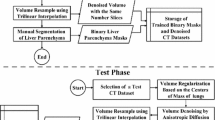Abstract
The segmentation challenge of adrenal and surrounding tissues lie in the similar CT values and adhesion in a medical image. An adrenal segmentation model (SALS) based on shape associating level set is proposed to segment the adrenal accurately. The objective function of adrenal boundary is expressed by a level set model. The prior shape curve of the adrenal to be segmented is calculated by the gradual change relationship between the adrenal glands in adjacent CT images, and is converted into shape constraint term of the level set models. A 3D Laplace method is used to improve adrenal grey scale information. The improved result of CT image is converted into grey scale constraint term of the level set models. Under the two constraints, the objective function of adrenal boundary converges to the best boundary. The level set methods in the literature obtain a prior shape by training a large number of sample images, and use the shape modes to segment CT images. The SALS model does not depend on the sample images. The adrenal boundaries in sequence of CT images can be directly segmented by SALS model, and the segmented boundaries are more accurate than the traditional level set methods. The SALS model has stronger adaptability to adherent adrenal boundary.









Similar content being viewed by others
Change history
19 November 2019
The Publisher regrets an error on the printed front cover of the October 2019 issue. The issue numbers were incorrectly listed as Volume 91, Nos. 10-12, October 2019. The correct number should be: "Volume 91, No. 10, October 2019"
References
Erdi, Y. E., Mawlawi, O., Larson, S. M., Imbriaco, M., Yeung, H., Finn, R., & Humm, J. L. (2015). Segmentation of lung lesion volume by adaptive positron emission tomography image thresholding. Cancer, 80, 2505–2509.
Zheng, Z., Zhang, X. C., Zheng, S., Xu, H. F., & Shi, Y. D. (2018). Semi-automatic Liver Segmentation in CT Images Through Intensity Separation and Region Growing. Procedia Computer Science., 131, 220–225.
Lim, S. J., Jeong, Y. Y., & Ho, Y. S. (2006). Automatic liver segmentation for volume measurement in CT images. Journal of Visual Communication and Image Representation, 17, 860–875.
Lin, D. T., Lei, C. C., & Hung, S. W. (2006). Computer-aided kidney segmentation on abdominal CT images. IEEE Transactions on Information Technology in Biomedicine, 10, 59–65.
Kichenassamy, S., Kumar, A., Olver, P., Tannenbaum, A., & Yezzi, A. (1995). Gradient flows and geometric active contour models. International Conference on Computer Vision 810–815.
He, C. J., Li, M., & Zhan, Y. (2008). Adaptive Distance Preserving Level Set Evolution for Image Segmentation. Journal of Software., 19, 3161–3169.
Chan, T. F., & Vese, L. A. (2001). Active contours without edges. IEEE Transactions on Image Processing, 10, 266–277.
Wang, X. F., & Huang, D. S. (2010). Xu, H. An efficient local Chan-Vese model for image segmentation. Pattern Recognition, 43, 603–618.
Chan, T., & Zhu, W. (2005). Level Set Based Shape Prior Segmentation. IEEE Computer Society Conference on Computer Vision and. Pattern Recognition, 2, 1164–1170.
Kim, J., Cetin, M., & Willsky, A. S. (2007). Nonparametric shape priors for active contour-based image segmentation. Signal Processing, 87, 3021–3044.
Cremers, D., Osher, S. J., & Soatto, S. (2006). Kernel Density Estimation and Intrinsic Alignment for Shape Priors in Level Set Segmentation. International Journal of Computer Vision, 69, 335–351.
Schmid, J., Kim, J., & Thalmann, N. M. (2011). Robust statistical shape models for MRI bone segmentation in presence of small field of view. Medical Image Analysis, 15, 155–168.
Chen, S., Michael, L. D., & Radke, R. J. (2011). Segmenting the prostate and rectum in CT imagery using anatomical constraints. Medical Image Analysis, 15, 1–11.
Yeo, S. Y., Xie, X., Sazonov, I., & Nithiarasu, P. (2011). Level set segmentation with robust image gradient energy and statistical shape prior. IEEE International Conference on Image Processing., 6626, 3397–3400.
Osher, S., & Sethian, J. A. (1988). Fronts propagating with curvature-dependent speed: Algorithms based on Hamilton-Jacobi formulations. Journal of Computer Physics., 79, 12–49.
Andersson, S. B. (2008). Discretization of a Continuous Curve. IEEE Transactions on Robotics, 24, 456–461.
Hao, S., Barnett, A. H., Martinsson, P. G., & Young, P. (2014). High-order accurate methods for Nyström discretization of integral equations on smooth curves in the plane. Adv. Comput. Math., 40, 245–272.
Jiang, Y., & Li, Y. (2012). The research of the approximate algorithm based on cubic B-spline curves. Liverpool United Kingdom Information and Computing Science 5th International Conference on, pp. 23–26.
Chen, W. H., & Zhang, T. (2010). The study of cubic uniform rational B-spline interpolation algorithm. Machinery Design and Manufacture. 3–5.
Rousson, M., & Paragios, N. (2002). Shape Priors for Level Set Representations BT - Lecture Notes in Computer Science. Computer Vision — ECCV, 2002, 416–418.
Paragios, N., Rousson, M., & Ramesh, V. (2002). matching distance functions: a shape-to-area variational approach for global-to-local registration. European Conference on Computer Vision. pp. 775–789.
Yang, M., Yuan, Y., Li, X., Yan, P. (2011). Medical image segmentation using descriptive image features. Proceedings of the British Machine Vision Conference.
Dice, L. R. (1945). Measures of the amount of ecologic association between species. Ecology, 26, 297–302.
Belogay, E., Cabrelli, C., Molter, U., & Shonkwiler, R. (1997). Calculating the Hausdorff distance between curves. Information Processing Letters, 64, 17–22.
Author information
Authors and Affiliations
Corresponding author
Additional information
Publisher’s Note
Springer Nature remains neutral with regard to jurisdictional claims in published maps and institutional affiliations.
Rights and permissions
About this article
Cite this article
Zhang, G., Li, Z. An Adrenal Segmentation Model Based on Shape Associating Level Set in Sequence of CT Images. J Sign Process Syst 91, 1169–1177 (2019). https://doi.org/10.1007/s11265-018-1433-0
Received:
Revised:
Accepted:
Published:
Issue Date:
DOI: https://doi.org/10.1007/s11265-018-1433-0




